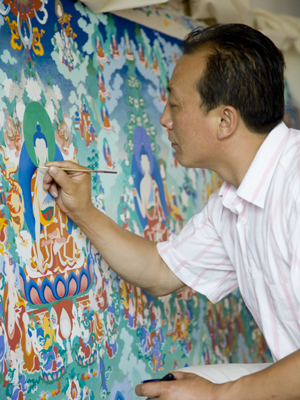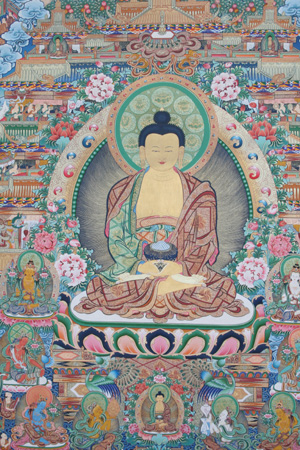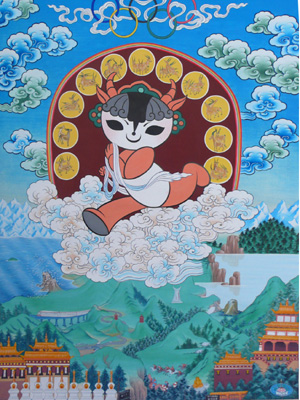"In the past, Thangka artists only passed on their craftsmanship to family members and never taught females," said renowned Thangka artist Niangben.
"I have broken both rules by setting up the Regong Painting Institute and receiving over 120 students including a female university student."

Photo shows renowned thangka artist Nyangbon painting a thangka, photo from People's Daily.
But Niangben has only one goal, that is, to "pass on the unique art of Thangka and make it known to the entire world."
"Thangka" is a religionary scroll painting on cloth or silk with various religious functions. The entire process of making thangkas demands great mastery over the drawing and perfect understanding of iconometric principles.
Niangben was born in 1971 in the village of Wutunshang in Tongren County, Huangnan Tibetan Autonomous Prefecture, northwest China's Qinghai Province.

Thangka created by Niangben and his students, photo from People's Daily.
At the age of 12, he started to learn the traditional Regong art of Tibetan Buddhism from Xiawu Tsering, "master of Chinese arts and crafts." In the 1990's, Niangben established the Regong Painting Institute to receive students. Niangben provided free meals and accommodation for them in order to allow more young people to learn and pass on Thangka art.
He is concerned that "many Thangka artists are quite old now and most of them live in a secluded life in temples. If more young people are not permitted to access Thangka art, many Thangka painting techniques might be lost."
Niangben is committed to the industrialized development of Thangka art. In recent years, the Regong Painting Institute has sold five to six hundred Thangka paintings domestically and even internationally every year.

Thangka created by Niangben and his students, photo from People's Daily.
The delicate Thangka paintings are made completely following traditional painting techniques and using carefully-selected materials. The pigment comes exclusively from natural mineral and raw plant materials. The paintings are drawn meticulously "line by line" by hand.
"It is vital to ensure quality, and publicize the art," Niangben said. In recent years, he has held a number of Thangka painting exhibitions across China and in Australia. Now a growing number of people are starting to like and understand the artistic value of Thangka. Thangka paintings have become one of the bestsellers in the collection market.
Niangben's greatest desire is for Thangka to become a world-famous art form. "I hope Thangka can go global, stand on the world art stage and become a world-famous art form."
